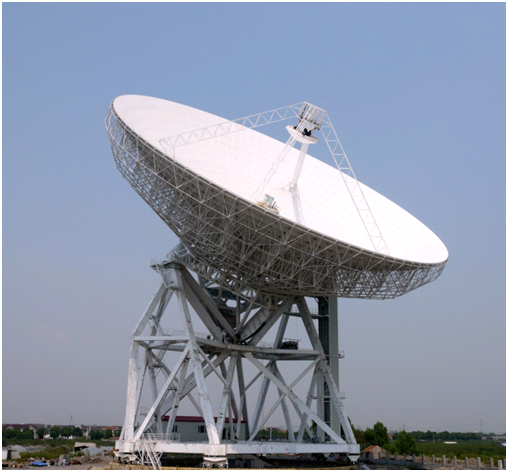Shanghai 65-Meter Radio Telescope Sees the First Light

After three years’ construction, the Shanghai 65-Meter Radio Telescope is close to its completion. In the second half of October, 2012, the mechanical structure, electrical system, network, control software of the telescope have been tested and they run smoothly. The test experiment was successfully carried out in the afternoon of October 26th, 2012. The astronomers and engineers witnessed the first light.
The first target is W3(OH) which is one of the famous star-forming regions and also strong maser sources in the Milky Way. It lies in an obscured part of the Perseus spiral arm of the Milky Way, at a distance of ~6400 light years from the Sun[1]. W3(OH) consists of a cluster of molecular clouds which are cradles of the massive stars. OH maser radiation arises from the most compact regions in the molecular clouds.
The test observations were made at 18 centimeter wavelength between UT 11:00-13:00. The frequency configuration was set to observe the 1665-MHz main line. The signals were received by a field amplifier following the corrugated horn and orthomode transducer (OMT) which are placed at the Cassegrain focus of the antenna, then transferred through cables to the terminal recording equipment (a spectrum analyzer was used in these experiment), eventually displayed on the screen of the control computer via TCP/IP protocols. The plot below shows the Stokes I spectrum of W3(OH) maser radiation acquired after 200-second integration.
The other targets, including three OH maser sources W49N, W51, W75N and two continuum sources Cygnus A and Cassiopeia A, were also detected.
The success of the test experiments indicates that the telescope is already in good condition and looks forward to commission in near future.

(From: Shanghai 65-Meter Telescope Team)
Notes:
Maser is the abbreviation of Microwave Amplification by Stimulated Emission of Radiation. See more details at http://en.wikipedia.org/wiki/Maser
OH, the hydroxyl radical, is the first astronomical maser and also the first molecule detected in the interstellar space at radio frequencies [2]. The energy level structure of this molecule is fairly complex. Each rotation state is split into four levels. The ground state transitions result in four spectral lines with wavelengths approximately at 18 centimeter, 1665, 1667, 1612 and 1720 MHz. The first two are called main lines, and the last two are satellite lines.
References:
[1]: Xu Y., Reid M.J., Zheng X.W., Menten K.M., 2006, Science, 311, 54
[2]: Weinreb S, Barrett A.H., Meeks M.L., Henry J.C., 1963, Nature, 200, 829
Download attachments: